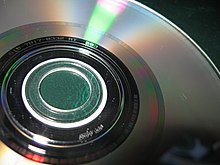TheGD-ROM(gigabytediscread-only memory) is a proprietaryoptical discformat developed as a collaboration betweenSegaandYamahafor theDreamcastand other Sega systems.[1]
 | |
 The underside of a GD-ROM disc | |
| Media type | Optical disc |
|---|---|
| Capacity | 1GB |
| Developedby | Yamaha |
| Usage | |
Specification
editA double-density format based on theCD-ROM[2]that could hold up to1GB,it consists of a single-densitytracknear the disc's center surrounded by a double-density track comprising much of the disc's capacity.[1]The GD-ROM was created in response to developers exceeding the typical650MBstorage capacity of the CD-ROM; whileDVD-ROMwould have addressed this limitation, implementing its then-new technology would have made console production cost prohibitive.[1]Along with the format's general novelty, the extra capacity also had the theoretical benefit of curbingvideo game piracy,[3][4]a major concern ofCD-based consoles that was validated by its rampancy on thePlayStation.[5][6]
Dreamcast console
editThe Dreamcast was considered by thevideo game industryas one of the most secure consoles on the market with its use of the GD-ROM,[7]but this was nullified by a flaw in the Dreamcast's support for the MIL-CD format, aMixed Mode CDfirst released on June 25, 1999, that incorporates interactive visual data similarly toCD+G.[8][9][a][b]Ahacker groupself-named Utopia released their exploit in June 2000, having discovered that they could replace the visual data with Dreamcast code, enabling games burned ontoCD-Rsto run on the console without anymodding;[8][12]boot discs were initially used to facilitate this effort, but hackers subsequently discovered the ability to have burned games self-boot without the need for a boot disc.[12][13]While copying Dreamcast games onto a CD-ROM sometimes required the removal of certain game features, this did not affect their playability; such games were typically distributed onfile sharingnetworks such asInternet Relay Chat.[12][14]Sega initially responded by aggressively pursuingcease and desistorders against online marketplaces selling pirated games, announcing the effort a month after the exploit's release;[7]the company eventually released a new revision of the Dreamcast hardware that removed MIL-CD support towards the end of 2000, closing the loophole.[15][16][17]Games released around that time also began to incorporate a more robust copy protection system to thwart illegitimate use.[18]
Before the Dreamcast was released, Sega "confirmed that Dreamcast owners will one day be able to upgrade the GD-ROM drive to DVD" as part of its general expansion system to keep it competitive against more powerful contemporaries.[19]In June 1999,The Nihon Keizai Shimbunreported on the development of a DVD distribution system by Sega alongsideHitachi,Nippon Columbia,and an additional partner; one known planned use for it involved encrypted multi-title releases that were to be accessed via downloadableproduct keys.[20]Despite displaying a Dreamcast DVD display unit at E3 2000,[21]the plans for a DVD add-on or fully separate unit never materialized during the short production run of the Dreamcast, rendering it the onlysixth generation consoleto not adopt the format.
Arcade systems
editGD-ROM was also made available as an upgrade for the Dreamcast's arcade cousin,Sega NAOMIand the laterSega NAOMI 2,providing alternate media to its cartridge-based software.[22][23]It is also used as an option on both theSega ChihiroandTriforce,respectively based on theXboxandGameCubeconsoles.[24][25]
The GD-ROM drive in the Dreamcast reads data inconstant angular velocity(CAV) mode at up to 12× speed.[1]
See also
editNotes
edit- ^The MIL-CD is only compatible with Japanese Dreamcast consoles due toregional lockout.[10]
- ^Unlike other mixed mode CDs, MIL-CD was capable of muting its data section from playback on typicalCD players,preventing potential damage to connected speakers.[9][10]Some GD-ROM titles include such a warning as an audio track.[11]
References
edit- ^abcdHagiwara, Shiro; Oliver, Ian (November–December 1999). "Sega Dreamcast: Creating a Unified Entertainment World".IEEE Micro.19(6):29–35.doi:10.1109/40.809375.
- ^Kent, Steven (November 23, 1998)."Here comes Sega's Dreamcast".ZDNet.RetrievedJuly 5,2024.
- ^Ohbuchi, Yutaka (September 30, 1998)."New Look at Dreamcast".GameSpot.RetrievedJuly 5,2024.
- ^Robinson, John (September 9, 1999)."Sega unleashes a 128-bit monster on the gaming world".CNN.RetrievedJuly 5,2024.
- ^Scullion, Chris (30 November 2023)."The Games".The Dreamcast Encyclopedia: Every Game Released for the Sega Dreamcast.White Owl.p. 12.ISBN978-1-5267-7224-4.RetrievedJuly 4,2024– viaGoogle Books.
- ^Diver, Mike (April 18, 2024)."Dreamcast".THE CON50LE: 50 Years of Home Video Gaming.White Owl.p. 120.ISBN978-1-3990-4050-1.RetrievedJuly 4,2024– viaGoogle Books.
- ^ab"Sega Crushes Dreamcast Pirates".Wired.July 20, 2000.RetrievedJune 15,2024.
- ^abKohler, Chris (October 2005)."Retro-Hack the Dreamcast".Retro Gaming Hacks.O'Reilly Media.ISBN9780596009175.
- ^ab"First MIL CDs released in Japan".IGN.June 28, 1999.RetrievedJune 15,2024.
- ^abGantayat, Anoop (June 7, 2000)."Soundtrack Review: Kitahe - Pure Songs and Pictures".IGN.RetrievedJune 17,2024.
- ^Johnston, Chris (February 1999). "Hands On: Dreamcast".Electronic Gaming Monthly.No. 115.Ziff Davis.p. 26.
- ^abcBorland, John (June 30, 2000)."Hackers break Dreamcast safeguards, distribute games online".CNET.Archived fromthe originalon October 29, 2014.RetrievedOctober 28,2014.
- ^Carless 2004,p. 217
- ^"Sega Shuts Down Computer Game Pirates".ABC News.July 21, 2000.RetrievedJuly 4,2024.
- ^Carless 2004,p. 199
- ^Gantayat, Anoop (January 16, 2001)."Sega Kills MIL CD Format".IGN.RetrievedJune 10,2024.
- ^Zackheim, Ben (January 27, 2005)."The Dreamcast never dies".Engadget.RetrievedJune 13,2024.
- ^Bramwell, Tom (January 18, 2001)."Sega Fights Piracy".Eurogamer.RetrievedJune 15,2024.
- ^"Dreamcast Expandability"(PDF).Electronic Gaming Monthly.Vol. 122. Ziff Davis. September 1999. p. 204.
- ^"Sega to Co-Develop DVD Technology for Use with Dreamcast?".IGN.June 8, 1999.RetrievedJune 11,2024.
- ^Justice, Brandon (May 12, 2000)."E3 2000: First Look – Dreamcast DVD Player".IGN.
- ^Gantayat, Anoop (September 20, 2000)."JAMMA 2000: Naomi 2 Revealed".IGN.RetrievedJune 12,2024.
- ^"SEGA Arcade Continues Its Dominance".IGN.February 9, 2001.RetrievedJune 12,2024.
- ^Gantayat, Anoop (September 19, 2002)."JAMMA 2002: First Look at Chihiro".IGN.RetrievedJune 12,2024.
- ^Gantayat, Anoop (February 21, 2002)."AOU2002: First Triforce Game Footage".IGN.RetrievedJune 12,2024.
Bibliography
editCarless, Simon(2004).Gaming Hacks.O'Reilly Media.ISBN978-0-596-00714-0– viaGoogle Books.